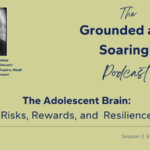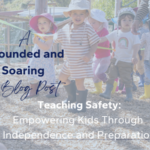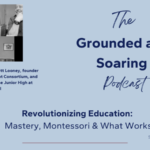Originally published in the Independent School Magazine, Summer 2015.
By Sam Shapiro
AT THE ATHENIAN SCHOOL (California), we’ve been asking ourselves a new and vital question: Given the hyperconnected and distracting culture in which we work and educate young people, how can we harness the benefits offered in such a technologized and high-octane world, and do it in a way that promotes and cultivates focus, compassion, efficiency, and well-being? More bluntly, how do we avoid the opposite: adults and students who are harried, distracted, disconnected, too busy to care, and ultimately shallow as thinkers and citizens. The solutions to the challenge are, of course, myriad, but one were particularly excited about, and about which much momentum is gathering in our school, is mindfulness. Based on ancient contemplative traditions, this potent antidote to the stressors of modern lives is a simple yet challenging practice that offers a deep dive into your physical, mental, and emotional experience. Jon Kabat-Zinn, the most well-known pioneer of the secular mindfulness movement, defines it as “paying attention in a particular way, on purpose, in the present moment, and nonjudgmentally.”
In the last two decades, researchers have revealed numerous compelling values gleaned from mindfulness practices. So much so, in fact, that courses in mindfulness are now being offered around the country to very diverse audiences: mindfulness classes for hospital patients suffering from chronic pain; for employees of Google, Goldman Sachs, and ExxonMobil for inmates in juvenile halls; for worshipers at Synagogues and churches; for kids in Oakland, California, public schools; and now, for Athenians.
LIGHTS UP THE MISSION
Why the enthusiasm? The demonstrated benefits of mindfulness continue to impress and inspire. Researchers at the University of Wisconsin recently discovered that people practicing mindfulness experience actual alterations in gene expression, allowing for stronger resistance to stress and increased resiliency. Other well-demonstrated positives include increased gray and white matter in practitioners’ brains, stronger immune system functioning, greater emotional stability and well-being, greater potency of focus, increased standardized test scores, and stronger capacity for and tendency to act compassionately when encountering others in distress. This last listed benefit that mindfulness practitioners act more compassionately — is especially noteworthy. A study by Professor David DeSteno, of Northeastern University, found that, when faced with what seemed to be a suffering patient in a medical office, the subjects who were engaged in an eight-week mindfulness training course did something remarkable. While only 16 percent of nonmeditators intervened to help the patient in pain, 50 percent of those involved in the mindfulness training program got up to help. This was especially impressive, because helping meant resisting the deleterious bystander effect and acting on their own when everyone else in the waiting room ignored the struggling patient.
We should pause and take this in: How many of us are in schools whose mission mentions the idea of developing caring, engaged citizens? While we know from recent research that activities like reading about characters through literature increases students’ tendencies to empathize with others, to feel their feelings, empathy isn’t enough. Brave compassionate action is a whole new level. It moves us beyond just emotionally comprehending others struggles to actually striving to alleviate the suffering itself. Our schools mission enjoins us to aim this high. Now we have a practice that we know fires up that noble aspiration to life.
WHAT WE DO
When we practice mindfulness meditation, as I do with my students at the start of every class and with teacher teams before I facilitate meetings, we sit in alert postures in our chairs, close our eyes, and pay attention. Very close attention. In each moment, we bring awareness to our bodies, our breath, our thoughts, our feelings, our senses, and we simply watch it all unfold without judging it or trying to change anything that arises in the theater of our inner experiences. Sometimes we have to watch our minds judging ourselves for judging ourselves, and we often see ourselves trying to change the impulse to change into one of not trying to change. These moments of “metacognition on-steroids” get really interesting. Spend just a few minutes watching your mind, emotions, and body, and you’ll realize that simply within, there is never-ending richness to observe, consider, experience, understand, and, ultimately, with which to make friends. A common misunderstanding is that mindfulness is about getting rid of stress and discomfort. Rather, the truth is that mindfulness will often put us into the center of such inner storms. However, by — to adapt Kabat-Zinn’s definition of the practice – purposefully and nonjudgmentally paying sharp attention to that storm, moment by moment, noting carefully its nature and allowing it to be, something usually settles; the push and pull of our judgments and inner conflicts that rage within ourselves tend to calm. And by allowing our thoughts, emotions and sensations to rest in an attention of acceptance and curiosity, we do become friendlier with ourselves.
Instead of seeking to flee and distract ourselves away from our moment-by-moment experiences, we sink into them with interest and acknowledgment, and from this, a greater sense of ease is bound to develop. Do this mindfulness practice every day for about 20 minutes, and, in fact, as the research keeps showing, blood pressure lowers, attention sharpens, and greater emotional stability takes root. Why wouldn’t we want to offer this to our schools community?
BRINGING MINDFULNESS INTO THE SCHOOL
Our initiatives with mindfulness at Athenian started a few years back when about 15 employees signed up to participate in an optional eight-week training course with Kate Janke-Munding, founder of the HeartMind Education Project and a professional mindfulness coach. Meeting with Janke-Munding for an hour every week to learn and strengthen mindfulness practices, participants then spent 20 minutes each day on their own, practicing guided mindfulness by using MP3 recordings she offered to them on her website. The results of this experience were compelling. Word spread, and a second group of about 15 more adults began working with the coach for a second eight-week session in our spring semester.
At that same time, our learning support specialist became enthusiastic about mindfulness for students; she’d read about its efficacy for increasing focus and reducing anxiety. We drafted a model of a training course for students – once a week for six weeks, with 10 minutes of individual MP3 practice per day and pitched it to the community. Thinking we would need a minimum of six students to sign up to make the course fly, we were delighted when 18 kids committed to the class.
Soon after, a growing body of Athenian parents requested the mindfulness training for themselves – clearly our Schools parents face a similar panoply of pressures and distractions — so we launched an eight-week parent class with 20 participants and Io on the waitlist.
Finally, in June 2014, Janke-Munding and I offered a residential mindfulness and compassion retreat for anyone who works in the life of a school—public or independent. Forty-five educators and school leaders from around California participated. This event functioned on two levels, giving individual faculty and administrators the chance to unplug and rejuvenate and offering guidance and silent practice periods through which they could strengthen valuable mindfulness and compassion practices.
INTEREST GROWING
This recent focus on mindfulness at Athenian has drawn interest from others in the field. Recently, Camille Rae Whitney, a researcher in educational policy at Stanford University, began studying the Athenian adults involved with our eight-week mindfulness course. In particular, she examined the influence of the program on teachers’ and administrators’ focus, stress, job satisfaction, emotional regulation at work, and well-being. Her findings reflected many of the positives that the adult participants reported to us in anonymous evaluations at the end of the first eight-week session in the fall.
STARTING THE GROUNDSWELL
Just a few years ago, it was more challenging to get School communities to take mindfulness seriously: The word meditation” conjured negative and “oovy-groovy” associations for many people, and those of religious faiths often perceived it as a threat or somehow a contradictory practice. Fortunately, the secular mindfulness movement has hit the mainstream, and the word mindfulness” itself has entered our vernacular. Given the tremendous volume of press and positive attention the practice is garnering, now is an opportune time for schools to embrace and incorporate this simple, yet profound practice.
Convincing parents, students, and faculty of its benefits is not difficult. Depending on their priorities, everyone can identify a demonstrated benefit about which to get excited: less stress, improved test scores, stronger resiliency, greater compassion. And, because the practice is usually done in chairs, in classrooms, and without esoteric accoutrements (no incense or chanting needed), it doesn’t take long before gathering together in school, closing our eyes, and cultivating attention feels like the sensible learning and leadership tool that it is. When schools ask me about bringing mindfulness to their faculty and community, I suggest starting slowly: Spark interest and enthusiasm among early adopters,” making the training voluntary. As the benefits begin showing up, and they will, others will take notice and want in. At some point the momentum will build and tip the school community to be ready to embrace and adopt sincerely the commitment to practice and support the goals of presence and compassion. In the end, it seems to come down to this: Everyone wants to feel better and be better. Quickly we see that mindfulness gives us this. It’s really not so complicated.
In addition to the mindfulness initiative, Shapiro is ninth-grade dean of instruction, assistant director of admission, and humanities faculty member at The Athenian School in the Bay Area of California. Recently he was an NAIS Teacher of the Future and NAIS Aspiring School Head. In 2015-16, he will begin his role as head of school at Marin Montessori School (California).
At the end of the first eight-week session, the adults at The Athenian School who participated in mindfulness practices reported clear benefits. Comments included.
“From day one of this course, I feel that my ability to focus, be more present, and have more patience was improved significantly, and im motiwated to continue this practice into the future.”
“I found our once-a-week meeting to be something I looked forward to with my colleagues, I felt closer to the colleagues with whom I shared this experience… ”
“Allowing myself to participate in this training has given me the reminder that I can practice mindfulness whenever and wherever intend — i.e., that this is a practice when done at its best is not only added to but also integrated within my daily life.”
“Since beginning this practice, the time it takes me to fall asleep each night has decreased significantly…. Also, my partner noticed the positive change, noting how | stop and think before speaking, keeping our conversations on course where before they might have become full-blown arguments.
“Mindfulness practice allows me to see the bigger picture, to be more patient and more accepting of things how they are.”
“This training was a wonderful gift.”

As Head of School, Sam is responsible for ensuring that Marin Montessori flourishes and that the School’s mission is brought to life each and every day.





